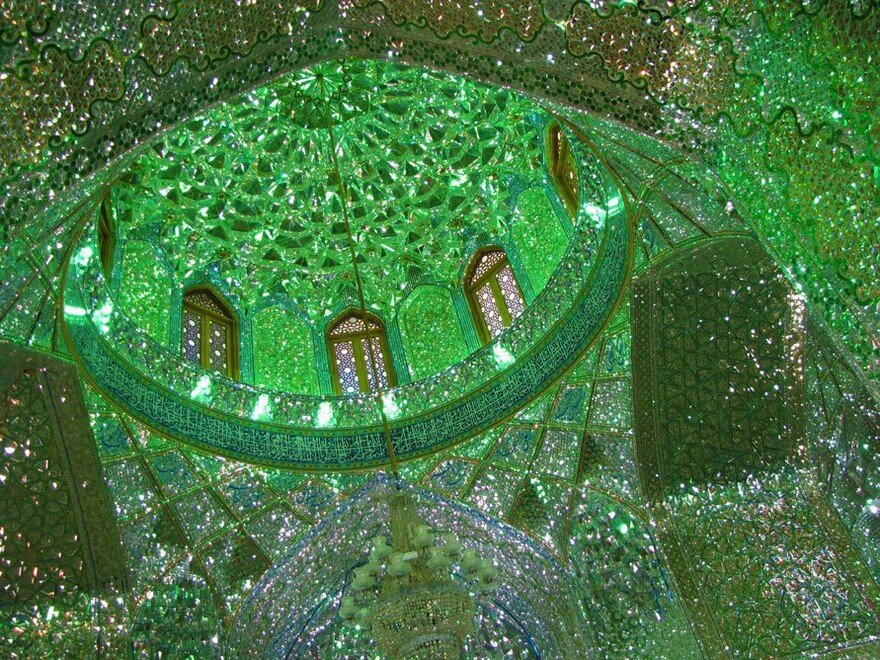Shah Cheragh Mosque: The Sacred 'King of Light' in Iran
Shāh-é-Chérāgh, translating to "King of the Light" in Persian, is the most important destination of pilgrimage within the city of Shiraz, Iran.
Nestled in one of ancient Persia's oldest and largest cities is an illustrious cultural jewel. This holy shrine embodies its namesake through the shimmering reflections of its mirrored mosaics of geometry and glass.
Image credit: IslamSciFi
The resplendent Shāh Chérāgh is the exalted mosque and mausoleum of Sayyed Mir Ahmad and Sayyed Mir Muhammad, the two sons of Mūsā al-Kādhim. Also called al-Kāzim, or the one who controls his anger, Mūsā al-Kādhim was a descendant of the prophet Muhammad, and the 7th Shiite Imam. In Shia Islamic faith, an Imam is an infallible being who acts as the political and spiritual successor of the late prophet of Islam. The importance of these two central figures of Islam is reflected in the reverently arranged facets of glass that adorn every inch of the hallowed architecture's interior.
Shāh-é-Chérāgh received its title as "King of the Light" because of the way it was discovered. In roughly 900 CE, Ayatullah Dastghā'ib went to investigate a shimmering light on the distant horizon. He came across a grave within a graveyard, and upon excavation, unearthed an armored carcass equipped with a ring that read al-‘Izzatu Lillāh, Ahmad bin Mūsā, or "The Pride belongs to God, Ahmad son of Musa". As a result of this finding, the site became known as the burial place of the 7th Imam's sons.
Due to the persecution of the Shiites in that time period, the two brothers, who were rightful heirs to the Shiite Imamate, were seeking refuge in Shiraz. It was there that they were assassinated by the Sunni caliphate in 835 CE.
The Sunni Muslims believed that the spiritual leaders of Islam should be elected by their merit rather than their lineage, and their fervent disagreement with the Shiites lead to the brothers' unfortunate demise. Nevertheless, their other brother, Alī ar-Ridhā, went on to take the seat as 8th Shiite Imam, and the two late siblings could only be honored in retrospect of the religious conflict.
A chamber, domed structure, and colonnaded porch were built by Amir Muqarrab al-din Badr al-din in approximately 1130 CE to honor the holy tomb. After 200 years had passed, the Queen Tash Khātūn undertook further development of the shrine. Between 1344-1349, the Mongolian Queen ordered reparations to the central structure as well as the construction of an audience hall, an art academy, an edifice and a tomb on the south side of the shrine for herself.
Image credit: IslamSciFi
In addition to this, the Queen introduced a unique Qur'an with 30 volumes, which was published containing gold decorations and golden thuluth characters in the trending calligraphy style of Yahya Jamali. Most of what Queen Tash Khātūn developed around the site is lost to time, but her remarkable "mirror ball" interior design still remains to captivate pilgrims and tourists alike, sustaining the clear link to her legacy in the history of Shāh Chérāgh.
Another 150 years passed and reparations were once again undertaken by the guardian of the mosque, Mirza Habibullah Sharifi, in 1506 CE. Soon after, an earthquake demolished half of the holy monument, prompting its subsequent repair in 1588 CE.
Throughout the 19th century, the fragile temple was repeatedly damaged and mended. An ornamental railing was installed by Fath-Ali Shah Qajar, a Qajar dynasty emperor, in 1827. A second earthquake came to claim the coveted sanctuary in 1852, but once again, the faith and diligence of Shāh Chérāgh's patrons ensured its refurbishment.
In 1958, the dome was removed due to the irreversible cracks in the massive structure. It was reinstated with a lighter iron material in the shape of the original dome.
Today, Shāh Chérāgh encompasses the original portico accompanied by its ten columns, a vast sanctuary with soaring alcoves on all four sides to the east, a mosque to the west, as well as a complex of rooms and tombs surrounding the shrine. The latticed railing separates the dome from the tomb, demonstrating a traditional custom among Shiraz architecture. A boundless courtyard encloses the compound on three sides, framing the minarets that mark the edges of the portico.
Image credit: IslamSciFi
The internal decoration is said to be a magnificent display of kaleidoscopic light and glass geometry, constantly changing yet conforming with the overall aesthetic. The inspiration for this otherworldly hall of lights appears to be psychedelic or divine in nature, but its possible that the devout prayer and meditation of any great spiritual artist, regardless of their beliefs, is all it takes to access the ether and yield these miraculous creations. Shāh Chérāgh is a brilliant testimony of the collective unconscious and its ability to express ineffable truth through the artists of every spiritual tradition.
References
https://www.youtube.com/watch?v=b9IFK8i0iSM
http://untoldpersia.com/ContentView/Pid/139/title/Shah-Cheragh-Shrine-Complex
https://en.wikipedia.org/wiki/Musa_al-Kadhim
https://en.wikipedia.org/wiki/Shah_Cheragh
https://nl.wikipedia.org/wiki/Sjah_Tsjeragh
https://en.wikipedia.org/wiki/Shiraz#Tourist_attractions_in_Shiraz
https://en.wikipedia.org/wiki/Imamate_(Twelver_doctrine)
https://en.wikipedia.org/wiki/Sunni_Islam




